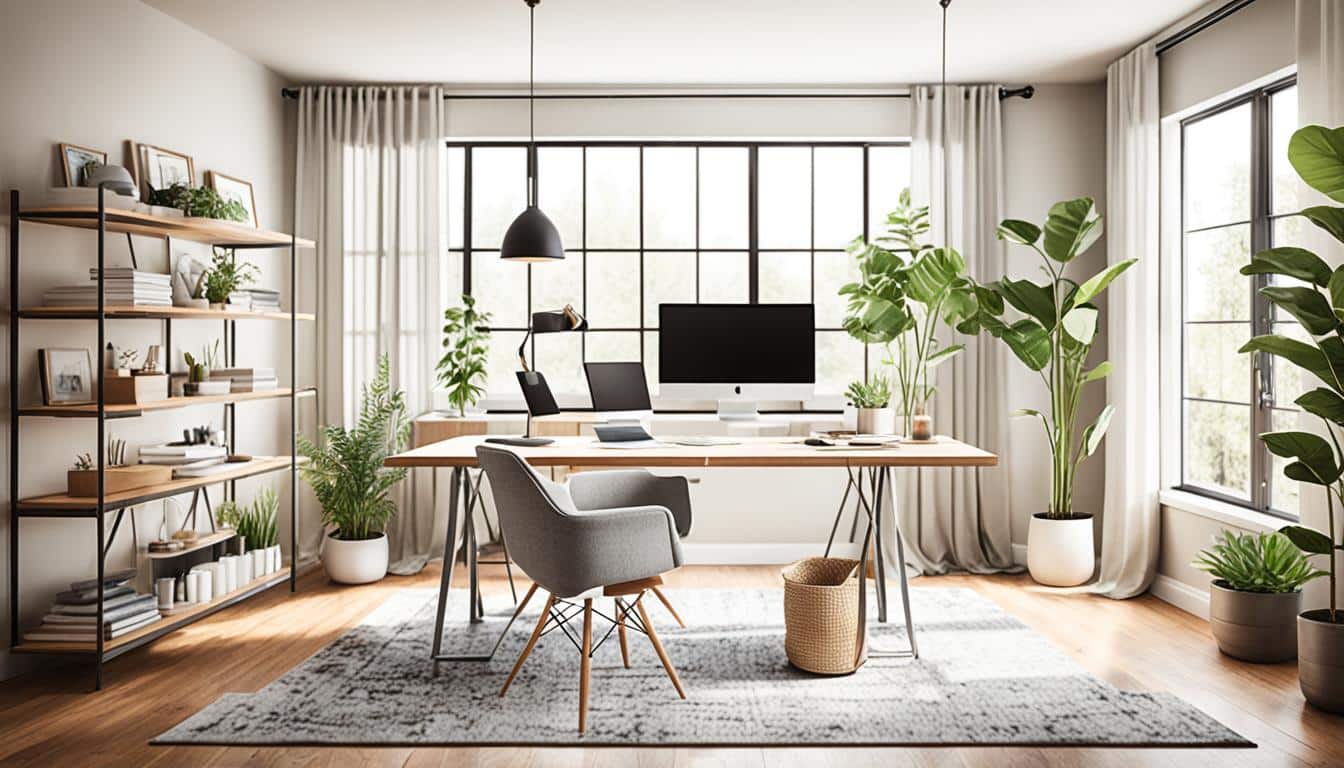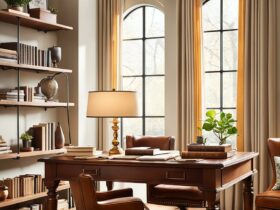If you have a knack for creativity and a passion for transforming spaces, interior design might be the perfect career path for you. Interior design is not just about making spaces visually pleasing but also about creating functional and comfortable environments. It is a real and professional field that offers numerous benefits and opportunities.
Working as an interior designer allows you to unleash your creativity and express your unique design style. You get to work closely with clients, understand their needs and preferences, and bring their visions to life. It is a collaborative process that requires excellent communication and interpersonal skills.
To pursue a career in interior design, a bachelor’s degree in interior design or a related field is typically required. Some states may also require interior designers to be licensed, ensuring their competency in the profession. This formal education equips you with the necessary knowledge and skills to tackle diverse design projects.
As an interior designer, your job duties can vary widely. You will meet with clients, conduct research, create designs, select materials, and oversee installations. This variety keeps the work exciting and allows you to continuously learn and grow as a professional.
The salary potential in the interior design industry can be quite lucrative, but it varies based on factors such as experience, education, and location. With experience and a solid portfolio, you can attract high-paying clients and build a successful career in the field.
Moreover, the demand for interior designers continues to rise, ensuring job security and ample opportunities for growth. From residential and commercial projects to hospitality and healthcare spaces, interior designers are needed in various industries.
Key Takeaways:
- Interior design is a real and professional field that offers numerous benefits and opportunities.
- It requires a bachelor’s degree in interior design and may require licensing in some states.
- Interior designers have a wide range of job duties, including meeting with clients, conducting research, creating designs, selecting materials.
- The salary potential in the interior design industry varies based on experience, education, and location.
- The demand for interior designers is increasing, providing job security and growth opportunities.
What is Interior Design?
Interior design is the art and science of enhancing the interior of a building to create a more aesthetically pleasing and functional environment for the people using the space. It is a profession that involves a combination of creativity, technical skills, and knowledge of design principles.
Interior designers are responsible for planning, researching, coordinating, and managing projects to create spaces that meet the client’s needs and desires. They work with architectural features, select furniture and finishes, and consider factors like lighting and color to create a cohesive and visually appealing design.
One of the key aspects of interior design is space planning. Interior designers carefully analyze the available space and determine how best to utilize it to optimize functionality and flow. They consider factors such as traffic patterns, furniture placement, and the overall layout of the space to create a harmonious and efficient design.
Design execution is another crucial aspect of interior design. Once the design concept is finalized, interior designers oversee the implementation of the design. They work closely with contractors, suppliers, and other professionals to ensure that the design vision is brought to life.
“Interior design is about creating transformative spaces that not only look beautiful but also improve the lives of those who inhabit them. It is the marriage of art and functionality, where every element and detail is carefully considered and curated.” – Emily Thompson, Interior Designer
In essence, interior design is about enhancing the quality of life for individuals by creating spaces that are visually stunning, functional, and tailored to their needs. Whether it’s a residential home, office space, or retail store, interior design has the power to transform and elevate the human experience.
Role of an Interior Designer
The role of an interior designer goes beyond just choosing paint colors and furniture. Interior designers are responsible for:
- Understanding the client’s needs, preferences, and budget
- Creating design concepts that align with the client’s vision
- Developing detailed plans, including floor plans, elevations, and renderings
- Selecting furniture, finishes, fabrics, and accessories
- Collaborating with architects, contractors, and other professionals
- Overseeing the implementation and installation of the design
- Ensuring that the project stays within budget and meets the required deadlines
Interior designers bring together their artistic flair, technical knowledge, and project management skills to deliver spaces that are both visually appealing and functional. They have the ability to transform ordinary spaces into extraordinary ones, creating environments that inspire and delight.
Skills and Qualities of an Interior Designer
Successful interior designers possess a combination of skills and qualities that enable them to excel in their profession. Some of the key skills and qualities include:
| Skills | Qualities |
|---|---|
|
|
These skills and qualities enable interior designers to navigate the complexities of the design process, communicate effectively with clients and professionals, and ultimately create spaces that exceed expectations.
How to Start a Career in Interior Design
If you have a passion for design and want to pursue a career in interior design, there are several steps you can take to get started. Here is a guide to help you kickstart your interior design journey:
Earn a Degree in Interior Design
Obtaining a bachelor’s degree in interior design from an accredited institution is typically the first step in starting your career. This degree program will provide you with a solid foundation in design principles, space planning, color theory, and more. It will also give you the opportunity to develop your creativity and technical skills through hands-on projects and studio experiences.
Get Licensed
In some states, interior designers are required to be licensed. This usually involves passing an exam administered by a professional organization, such as the National Council for Interior Design Qualification (NCIDQ). Becoming licensed not only validates your expertise but also gives you a competitive edge in the industry.
Continue Your Education
To stay at the forefront of the industry and enhance your skills, consider pursuing advanced degrees or certifications. These additional qualifications can further validate your expertise and open doors to specialized career opportunities. From sustainable design to healthcare design, there are various areas of specialization you can explore.
Stay Updated on Trends and Designs
Interior design is a constantly evolving field, with new trends and designs emerging all the time. It’s crucial for aspiring interior designers to continuously learn and stay updated on these trends. Follow industry blogs, attend design conferences, and engage with fellow designers to keep yourself informed and inspired.
Build Your Portfolio
A strong portfolio is essential for showcasing your skills and creativity to potential clients and employers. As you complete projects and gain experience, be sure to document your work and include it in your portfolio. This will demonstrate your design aesthetic, problem-solving abilities, and attention to detail.
Embarking on a career in interior design requires dedication and hard work. However, the reward of transforming spaces and creating beautiful environments for people to live, work, and play in is worth the effort. With the right education, training, and passion, you can turn your love for design into a fulfilling and successful career in interior design.
Pros and Cons of Interior Design
Like any profession, there are pros and cons to working in interior design. Understanding these advantages and disadvantages can help individuals make informed decisions about pursuing a career in this field.
Advantages of Interior Design
- Expression of Creativity: Interior design offers the opportunity to unleash your creative side, allowing you to design spaces that reflect your unique style and vision.
- Good Salary Potential: The interior design industry offers the potential for a good salary, especially for experienced professionals with a strong portfolio and client base.
- Satisfaction of Transformation: One of the most rewarding aspects of interior design is the satisfaction of helping clients transform their spaces into beautiful and functional environments that meet their needs and desires.
- Job Security: As long as people continue to live and work in buildings, there will be a need for interior designers. This provides job security and stability in the field.
- Opportunities for Growth: Interior design offers various opportunities for growth, such as specializing in specific design styles or areas, expanding into project management roles, or even starting your own design firm.
Disadvantages of Interior Design
- Competition: The interior design industry is highly competitive, with many talented designers vying for the same clients and projects. Standing out in a crowded market can be a challenge.
- Formal Education and Licensing: Becoming an interior designer typically requires formal education and licensing, which can involve significant time and financial investment.
- Long Hours: Interior designers often work long hours, especially during project deadlines or when juggling multiple clients. This can lead to a demanding and potentially stressful work schedule.
- Strong Work Ethic: Success in the interior design industry requires a strong work ethic, as designers must navigate deadlines, manage client expectations, coordinate with contractors and suppliers, and handle various other tasks.
It is important for individuals considering a career in interior design to carefully weigh these pros and cons. Assessing personal interests, strengths, and career aspirations can help determine if the advantages outweigh the challenges, ultimately leading to a fulfilling and successful career in interior design.

Alternate Design Career Paths That May Interest You
While interior design is a popular career choice, there are also alternative design career paths that individuals may find interesting. Exploring these alternate paths allows individuals to utilize their creative and design skills in different industries. Some of the exciting alternate design careers include:
1. Product Design

Product design involves creating unique and practical products that enhance people’s lives. Designers in this field use their creativity and technical skills to develop innovative solutions, considering both aesthetics and functionality. From consumer electronics to household appliances, product designers have the opportunity to design products that have a tangible impact on society.
2. Visual Merchandising
Visual merchandising is an art form that encompasses creating attractive and enticing store displays. Designers in this field combine aesthetics, marketing psychology, and product knowledge to create visually appealing arrangements. By creating compelling displays, visual merchandisers enhance the overall shopping experience and play a crucial role in driving sales and brand identity.
3. Event Planning
Event planning is a dynamic career that involves organizing and coordinating various events. Designers in this field have the opportunity to create memorable experiences by considering the overall design and ambiance of an event. From selecting themes and decorations to managing logistics and coordinating vendors, event planners bring concepts to life and ensure the smooth execution of events.
4. Graphic Design
Graphic design is a versatile field that focuses on creating visual content for marketing and communication purposes. Designers in this field collaborate with clients to develop impactful designs for branding, advertising, packaging, and digital media. By combining creativity with strong technical skills, graphic designers craft compelling visuals that effectively convey messages and evoke desired emotions.
5. Fashion Design
Fashion design offers individuals the opportunity to express their creativity through clothing and accessory design. Fashion designers develop unique styles, experiment with fabrics and patterns, and create collections that reflect their artistic vision. From sketching initial designs to overseeing manufacturing, fashion designers play a vital role in shaping the industry’s trends and aesthetics.
These alternate design career paths provide individuals with diverse opportunities to channel their passion for design into different industries. Each path offers its own unique challenges and rewards, allowing individuals to explore their creativity and make a meaningful impact in the world of design.
Conclusion
In conclusion, interior design is a dynamic and rewarding career path for individuals who have a passion for design and creativity. With formal education and licensing, interior designers have the opportunity to create functional and visually appealing spaces that have a positive impact on people’s lives. Whether it’s transforming a home, office, or retail space, interior designers play a crucial role in improving the overall aesthetic and functionality of the environment.
One of the key advantages of pursuing a career in interior design is the potential for a good salary. As the demand for skilled interior designers continues to rise, professionals in this field can enjoy competitive salaries and benefits. Additionally, there are ample opportunities for career growth and job security, making it an attractive choice for individuals looking to establish a long-term career.
While there are challenges in the industry, such as competition and the need for continuous learning, the overall rewards and satisfaction of a career in interior design make it a fulfilling profession. By leveraging their creativity, technical skills, and understanding of design principles, interior designers have the power to create spaces that bring joy and functionality to their clients.
In conclusion, interior design as a career offers a perfect blend of artistic expression, problem-solving, and client collaboration. If you have a passion for design and the desire to make a positive impact on people’s lives, a career in interior design may be the ideal choice for you. Embark on this exciting journey and unlock the endless possibilities that await in the world of interior design.
FAQ
Why should I consider a career in interior design?
A career in interior design offers numerous benefits and opportunities. It allows you to express your creativity, offers the potential for a good salary, and provides job security and opportunities for growth.
What is interior design?
Interior design is the art and science of enhancing the interior of a building to create a more aesthetically pleasing and functional environment. Interior designers plan, research, coordinate, and manage projects to create spaces that meet the client’s needs and desires.
How do I start a career in interior design?
To start a career in interior design, you typically need to obtain a bachelor’s degree in interior design from an accredited institution. Some states also require designers to be licensed, which usually involves passing an exam. Continuous learning and staying updated on new trends and designs is also important.
What are the pros and cons of working in interior design?
Some advantages of working in interior design include the ability to express creativity, the potential for a good salary, and the satisfaction of helping clients transform their spaces. However, there are challenges such as competition, the need for formal education and licensing, long hours, and the requirement for a strong work ethic.
Are there alternative design career paths?
Yes, there are alternative design career paths that may interest you. These include product design, visual merchandising, event planning, graphic design, and fashion design. These paths still allow individuals to use their creativity and design skills in different industries.










